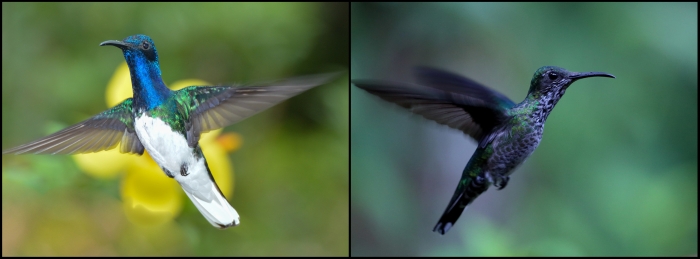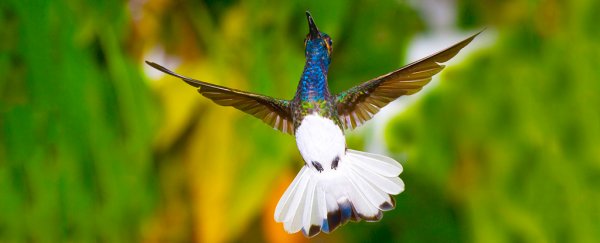When it comes to birds, sexual dimorphism can be very pronounced indeed.
Males may announce their presence with flashy feathers, while females of the same species are much more sedate - an adaptation thought to be related to sexual selection and reproduction.
While not universal for all birds, such was thought to be the case for the white-necked jacobin (Florisuga mellivora). But scientists have now discovered that a significant number of the females of this hummingbird species are brilliantly colored, just like the males.
This, they found, helps to prevent aggressive behavior the males tend to direct at female hummingbirds during feeding, including pecking and body-slamming to assert dominance over food.
"One of the 'aha moments' of this study was when I realized that all of the juvenile females had showy colors," said ornithologist Jay Falk, now of the University of Washington, and formerly of the Cornell Lab of Ornithology and Smithsonian Tropical Research Institute.
"For birds that's really unusual because you usually find that when the males and females are different, the juveniles usually look like the adult females, not the adult males, and that's true almost across the board for birds.
"It was unusual to find one where the juveniles looked like the males. So it was clear something was at play."
 (William Stephens, iNaturalist, CC-BY & Erland Refling Nielsen, iNaturalist, CC BY NC)
(William Stephens, iNaturalist, CC-BY & Erland Refling Nielsen, iNaturalist, CC BY NC)
The difference between male and female plumage in the white-necked jacobin is striking. Males (left, in the image above) have shimmering blue heads, green backs, and white bellies and tails, with a white band on the back of the neck. The females (right) are more subdued green and black, with their white necks and bellies speckled with darker feathers, and darker tails.
Or rather, that's what we thought. As Falk and his team noted, all the juveniles - male and female - have more colorful plumage.
As they mature, however, only around 80 percent of females change their outfits. The remaining 20 percent kept their flashy duds, making them practically indistinguishable from the males at a glance.
The reason for this wasn't exactly clear, so the researchers designed an experiment to observe how the birds interact based on their coloring. They set up a hummingbird feeder, and added different taxidermy mounts to observe how that may alter the interactions of visiting wild birds.
There were three combinations of two mounts: male and heterochromatic (subdued coloring) female; male and androchromatic (colorful plumage akin to male) female; and both heterochromatic and androchromatic female.
Hummingbirds tend to compete aggressively for food resources, even among their own species, so the researchers recorded both sexual and aggressive interactions amongst the birds.
They were trying to determine if the androchromatic females were preferred as mates, which would suggest that their bright coloring had a sexual selection benefit.
Interestingly, the males still preferred the more plainly-colored females sexually. In 100 percent of the trials, the first sexual advance was made towards a heterochromatic female - ruling out mate selection as a reason for the bright coloring.
However, the flashy androchromatic females were much less frequently the target of aggression during feeding when paired with a heterochromatic female. When both taxidermy mounts, one male and one female, had the vivid coloring, the wild males showed no bias in where they directed their aggression.
This suggests that disguising themselves as males reduces the rate at which females are socially harassed by males - which, in some cases, seems to be preferable to appealing to them sexually. Raise your hand if you can relate.
"During the 26 trials of the mount experiment, we witnessed 1,790 instances of aggression toward mounts .. and 359 chases involving wild white-necked jacobins," the researchers wrote in their paper.
"Aggression was therefore frequent, and androchrome plumage effectively reduced these encounters."
Interestingly, this could explain the unusual coloring of the juveniles. As Falk noted, most species of birds with sexually dimorphic plumage tend to have the more camouflaged adult female coloring, which can help protect vulnerable fledglings from predators. Bright coloring in juveniles suggests that, at least in white-necked jacobins, they need greater protection from their own kin.
The team hopes, in future research, to use their findings to learn how and why other species might have evolved sexually dimorphic traits.
"Hummingbirds are such beloved animals by many people, but there are still mysteries that we haven't noticed or studied," Falk said.
"It's cool that you don't have to go to an obscure unknown bird to find interesting and revealing results. You can just look at a bird that everyone loves to watch in the first place."
The research has been published in Current Biology.
